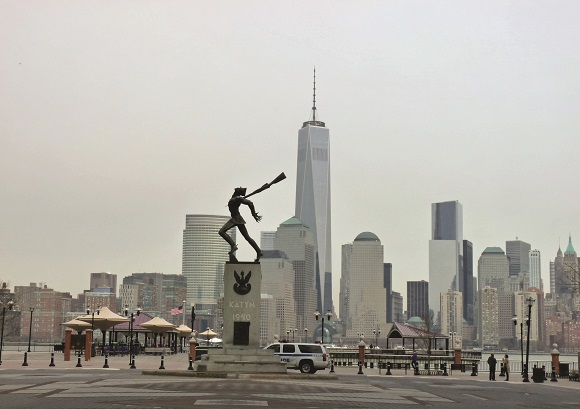How a secret gentrification plan tried to remove the Katyn Memorial
When news first broke on April 20th, 2018 of a plan to remove a WWII statue from the Jersey City waterfront, few Americans knew the significance of what the Katyn Memorial meant to the Polish-American communities of not only Jersey City, but also Greenpoint, Maspeth, Ridgewood, Middle Village and others throughout the tri-state area. No one could fault them for not knowing this often-buried but quite important massacre of 22,000 Polish POWs by Soviet secret police, which led to the dismantling of the Polish state in 1940, and many years of denial by both the USSR and Germany. However, even fewer suspected that a developer by the name of Mike DeMarco would become the principal actor in this hyper-gentrification tale of two waterfronts, which led to the incredible course of events in the fight to keep the Katyn monument where it stands in Exchange Place.
Gentrification: cause and effect
Let me take you back a few years to explain how this started. In 2005, the Brooklyn waterfront neighborhoods of Greenpoint and Williamsburg underwent a rezoning that heralded the start of unbridled hyper development, and the creation of a “gated community without gates” in the center of a working-class heartland. At the time, Mayor Bloomberg stated, “Our administration has looked to underused and abandoned stretches of our City's shoreline as the source of new affordable housing, new parks, and thriving new businesses – the keys to a greater New York.” With those keys in hand, a small group of mega-developers began transforming two miles of waterfront into the promised 54 acres of open space, including a continuous public esplanade, a 28-acre park, 10,800 new units of housing, and 3,500 apartments that would be deemed ‘affordable.’
Fourteen years later, the effects of this rezoning have created a glut of empty luxury apartments and ‘affordable’ housing that is well above the $44K/year Area Median Income of average Brooklynites. Eleven percent of our children have reported being homeless. There is a net loss of diversity and cultural history that is incalculable. The homogenization and mass displacement of this once cohesive European immigrant, Hispanic and Black neighborhood has been cited around the world as a case of city planning gone terribly wrong. Our streets were renamed, our churches, libraries and schools were sold, and the history of our immigrant past has become systematically wiped out. Williamsburg has, in fact, become the quintessential case study for what not to allow to happen to our neighborhoods – or so we thought.
The DeMarco plan
And here we meet Jersey City mega developer Mike DeMarco, CEO of Mack-Cali Realty Group. Mack-Cali has earned a name as the most prolific owner of suburban office parks across the Northeast, but since 2016, has sold hundreds of millions of dollars of these assets to redirect investments into waterfront-centric commercial and residential holdings. The man in charge of spearheading this transition was Mr. DeMarco himself. Before DeMarco, Mack-Cali’s CEO was Mitchell Rudin, who DeMarco quickly pushed out. But before Mack-Cali, Rudin was CEO of Brookfield Properties, a name that is ubiquitous with mega development in Brooklyn. They joined forces with Park Tower Group in 2015 to build the controversial 11 tower, 22-acre development at Greenpoint Landing. This was, admittedly, a year after Rudin left Brookfield, however the incestuous relationships of real estate powerbrokers like Rudin and DeMarco provided them with a high level of access to what was happening on Brooklyn’s waterfront.
It is no wonder then, that in a 2016 investment overview for Roseland (a subsidiary of Mack-Cali’s), juxtaposed images of property assets in Jersey City’s Exchange Place, and Williamsburg’s Kent Ave, are practically mirrors of each other. The comparison is uncanny because it demonstrates that the 2005 Greenpoint-Williamsburg rezoning had become a master plan for developing homogenized waterfront areas across the country, and Jersey City was just another ink-stained stamp.
Collusion uncovered
I first came across the term “Williamsburg master plan” when I read through the hundreds of Open Public Records Act (OPRA) files delivered to a Jersey City resident named Mike Kulowski, who was investigating the role that the Exchange Place Alliance Special Improvement District played in the removal of the Katyn monument. This Special Improvement District was controversial for several reasons. First, because it was headed by DeMarco himself, second because his Hyatt hotel property overlooks the monument, and third because its quid pro quo relationship with Mayor Fulop’s administration was long suspected to be at the expense and detriment of Jersey City taxpayers.
These OPRA requests revealed a long and well-thought out plan of collusion, blatant lies and fraud that spanned back to at least the summer of 2016. DeMarco’s plan to remove the Katyn statue to make way for a private valet entrance for the Hyatt would rely on a certain rezoning document that he became intimately aware of – the “Williamsburg master plan.” His strategy was to hide behind a progressive mayor and open space advocates to sell the idea of a new park, which in its design could be considered little more than shrubbery around the valet entrance.
But with an outspokenly progressive mayor and city council, how could a Machiavellian plan such as this find support? The answer is just as simple. Mayor Steven Fulop is an ambitious 41-year-old former Goldman Sachs banker who ran for governor in 2017, but dropped out of the race when he stated, “There were health issues, there was a scandal. None of that stuff materialized now that we look back a year and a half later.” The scandal is still speculative, however what we do know is that Mike DeMarco gave the Fulop-led Coalition for Progress super PAC $250,000 in 2016. When Fulop dropped out of the race, DeMarco thought his investment had gone out the window. Until, that is, he called on the mayor to help him improve his waterfront hotel.
The same OPRA requests that revealed the Williamsburg master plan, revealed email exchanges between Mayor Fulop, Exchange Place Alliance Executive Director Elizabeth Cain, JC Director of Cultural Affairs Christine Goodman, JC Director of Engineering Joe Cunha, JC Senior Landscape Architect Drew Banghart, Director of Supor Crane and Rigging Paul Gaspar, and many others, who drew up false narratives to tell the public that the statue would return, created scoping invoices and price quotes for its removal during a federal injunction, and talked openly about removing the statue at midnight under a heavy police presence. They had zero intention of spending that money twice to bring it back to Exchange Place and had colluded with certain spineless representatives of the Polish government who were offered a franchise agreement to pay hundreds of thousands of dollars for the removal, storage and move of the statue to a small back alley a block away. Audio recordings of their backdoor shenanigans have recently leaked to the public.
Public outrage and a lawsuit
This plan would have been brilliantly executed if it were not for the efforts of the Jersey City public and Polish-American community to save the location-specific Katyn artwork that aligns with the Freedom Tower and harkens back to its original symbols of freedom.
But while the public and Polish community rallied around a referendum campaign to overturn the City Council’s decision to move the statue – which was doomed from the start because it was based on an illegal ordinance – local Jersey City activist Maria Scariati used the information gathered from the OPRA documents as a basis to sue Mayor Fulop and the City Council. The process of further discovery and potential depositions would have made for quite the daytime court show, and Fulop knew frustrated and ignored Jersey City voters would be intently watching and listening. He was served papers on October 28th, and on November 6th he publicly announced that he acquiesced on the matter because he speculated the passage of a payroll tax would invite a competing referendum. This was, of course, an excuse to hide his fear of what the superior court lawsuit would reveal.
Although Fulop rescinded his desire to move the statue, he never fully agreed to leave it alone, so Scariati pushed forward with the lawsuit. On Friday, November 16th, Judge Bariso reviewed the prepared documents and offered to make a declaratory judgement during a pre-trial hearing. He stated that the original ordinance to move the statue was null and void, thereby avoiding the referendum and providing a clean pathway to create a solid protective ordinance for its permanent fixture at Exchange Place.
The takeaway
The lessons of this victory for the will of the people, and the cultural preservation of their immigrant history in a quickly homogenizing community, are twofold.
The most important thing to recognize is that calling oneself a “progressive” today is a red herring. Social justice, equity and equality are fundamentally important values for a society to thrive, however usurping progressivism to pervert its meaning, and using it as a smokescreen to promote real estate interests, is the sad and unfortunate place where we have come to in our politics.
The second thing to realize is that the pattern of tricks does not change. Steven Fulop is a spitting image in many ways to “progressive” Mayor Bill de Blasio. The Fulop-led Coalition for Progress super PAC shares an uncanny similarity to de Blasio’s now defunct Campaign for One New York super PAC. The Exchange Place Alliance shares many tactics for gaining air rights in exchange for parks with Williamsburg’s Open Space Alliance. A digital communications company called SeeClickFix operates a gentrification Big Brother army in both cities. Both have many of the same problems brought on by speculative real estate interests who have bought and paid for our political system. At times when I took the train back home to Brooklyn, I wondered if I was headed back to where I came from.
But what I ultimately learned from this experience was that speaking truth to power, although dangerous and intimidating, can be extremely vindicating and victorious. I also learned that many of the unwittingly complicit progressive representatives we hail for social justice causes are the same ones who we should be most wary of. True progress requires community-led vigilance to pass legislation and determine city plans that protect and cooperate with the will of the people, rather than powerful donors. This tale of two waterfronts should be a call to arms for New Yorkers and New Jerseyans alike – take back your cities, take back your history, and above all, question everything.
Victoria Cambranes is a community activist, a Polish-American, a lifelong resident of Greenpoint, and was at the forefront of the fight to save the Katyn monument.




